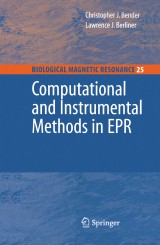Details

Computational and Instrumental Methods in EPR
Biological Magnetic Resonance, Band 25
|
CHF 118.00 |
|
| Verlag: | Springer |
| Format: | |
| Veröffentl.: | 27.12.2007 |
| ISBN/EAN: | 9780387388809 |
| Sprache: | englisch |
| Anzahl Seiten: | 222 |
Dieses eBook enthält ein Wasserzeichen.
Beschreibungen
Electron magnetic resonance in the time domain has been greatly facilitated by the introduction of novel resonance structures and better computational tools, such as the increasingly widespread use of density-matrix formalism. This second v- ume in our series, devoted both to instrumentation and computation, addresses - plications and advances in the analysis of spin relaxation time measurements. Chapters 1 deals with the important problem of measuring spin relaxation times over a broad temporal range. The author, Dr. Sushil Misra, has worked on a wide variety of solutions to problems in this area, with respect to both experimental and theoretical aspects, and Chapter 1 summarizes much of his recent work, which was enhanced by a fruitful collaboration with the late Professor Jacques Pescia. Chapter 2 presents solutions to the problem of measuring short spin relaxation times. Again, in collaboration and tribute to the late Jacques Pescia's laboratory, part of the chapter represents a translation of the amplitude modulation technique section from a doctoral thesis by Robert Lopez in 1993 to The Paul Sabatier U- versity. Experimental data that appeared in the original thesis are placed at the end of subsections that correspond to the described technique. Chapter 3 takes up the problem of multi-frequency ENDOR and ESEEM, and illustrates how small stepwise increments of spectrometer operating parameters can enable one to better determine spin-Hamiltonian parameters via a graphical analysis.
Microwave Amplitude Modulation Technique to Measure Spin-Lattice (T 1) and Spin-Spin (T 2) Relaxation Times.- Improvement in the Measurement of Spin-Lattice Relaxation Time in Electron Paramagnetic Resonance.- Quantitative Measurement of Magnetic Hyperfine Parameters and the Physical Organic Chemistry of Supramolecular Systems.- New Methods of Simulation of Mn(II) EPR Spectra: Single Crystals, Polycrystalline and Amorphous (Biological) Materials.- Density Matrix Formalism of Angular Momentum in Multi-Quantum Magnetic Resonance.
<P><STRONG>Computational and Instrumental Methods in EPR</STRONG></P>
<P></P>
<P><STRONG>Prof. Bender,</STRONG> Fordham University</P>
<P><STRONG>Prof. Lawrence J. Berliner,</STRONG> University of Denver</P>
<P></P>
<P>Electron magnetic resonance has been greatly facilitated by the introduction of advances in instrumentation and better computational tools, such as the increasingly widespread use of the density matrix formalism.</P>
<P></P>
<P>This volume is devoted to both instrumentation and computation aspects of EPR, while addressing applications such as spin relaxation time measurements, the measurement of hyperfine interaction parameters, and the recovery of Mn(II) spin Hamiltonian parameters via spectral simulation.</P>
<P></P>
<P><STRONG>Key features:</STRONG></P>
<UL>
<P>
<LI>Microwave Amplitude Modulation Technique to Measure Spin-Lattice (T<SUB>1</SUB>) and Spin-Spin (T<SUB>2</SUB>) Relaxation Times</LI>
<P></P>
<P>
<LI>Improvement in the Measurement of Spin-Lattice Relaxation Time in Electron Paramagnetic Resonance</LI>
<P></P>
<P>
<LI>Quantitative Measurement of Magnetic Hyperfine Parameters and the Physical Organic Chemistry of Supramolecular Systems</LI>
<P></P>
<P>
<LI>New Methods of Simulation of Mn(II) EPR Spectra: Single Crystals, Polycrystalline and Amorphous (Biological) Materials</LI>
<P></P>
<P>
<LI>Density Matrix Formalism of Angular Momentum in Multi-Quantum Magnetic Resonance</LI></UL>
<P><STRONG>About the Editors:</STRONG></P>
<P><STRONG>Dr. Chris Bender</STRONG> is assistant professor of Chemistry at Fordham University.</P>
<P><STRONG>Dr. Lawrence J. Berliner</STRONG> is currently Professor and Chair of the Department of Chemistry and Biochemistry at the University of Denver after retiring from Ohio State University, where he spent a 32-year career in the area of biological magnetic resonance (EPR and NMR). He is the Series Editor for Biological Magnetic Resonance, which he launched in 1979.</P>
<P></P>
<P><STRONG>Prof. Bender,</STRONG> Fordham University</P>
<P><STRONG>Prof. Lawrence J. Berliner,</STRONG> University of Denver</P>
<P></P>
<P>Electron magnetic resonance has been greatly facilitated by the introduction of advances in instrumentation and better computational tools, such as the increasingly widespread use of the density matrix formalism.</P>
<P></P>
<P>This volume is devoted to both instrumentation and computation aspects of EPR, while addressing applications such as spin relaxation time measurements, the measurement of hyperfine interaction parameters, and the recovery of Mn(II) spin Hamiltonian parameters via spectral simulation.</P>
<P></P>
<P><STRONG>Key features:</STRONG></P>
<UL>
<P>
<LI>Microwave Amplitude Modulation Technique to Measure Spin-Lattice (T<SUB>1</SUB>) and Spin-Spin (T<SUB>2</SUB>) Relaxation Times</LI>
<P></P>
<P>
<LI>Improvement in the Measurement of Spin-Lattice Relaxation Time in Electron Paramagnetic Resonance</LI>
<P></P>
<P>
<LI>Quantitative Measurement of Magnetic Hyperfine Parameters and the Physical Organic Chemistry of Supramolecular Systems</LI>
<P></P>
<P>
<LI>New Methods of Simulation of Mn(II) EPR Spectra: Single Crystals, Polycrystalline and Amorphous (Biological) Materials</LI>
<P></P>
<P>
<LI>Density Matrix Formalism of Angular Momentum in Multi-Quantum Magnetic Resonance</LI></UL>
<P><STRONG>About the Editors:</STRONG></P>
<P><STRONG>Dr. Chris Bender</STRONG> is assistant professor of Chemistry at Fordham University.</P>
<P><STRONG>Dr. Lawrence J. Berliner</STRONG> is currently Professor and Chair of the Department of Chemistry and Biochemistry at the University of Denver after retiring from Ohio State University, where he spent a 32-year career in the area of biological magnetic resonance (EPR and NMR). He is the Series Editor for Biological Magnetic Resonance, which he launched in 1979.</P>
The first comprehensive volume to offer practical, non-invasive spectroscopic methods of analyzing the rheology of biopolymers: comparative studies of polymer fluidity using traditional methods (e.g. viscosity) and nuclear magnetic resonance
Diese Produkte könnten Sie auch interessieren:

Alzheimer's Disease: Cellular and Molecular Aspects of Amyloid beta

von: J. Robin Harris, Falk Fahrenholz

CHF 236.00















